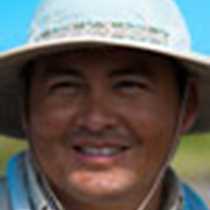Isabela and Fernandina Island
Isabela Island is the largest island of the Galápagos with an area of 4,640 square kilometers (1,790 sq. mi). This island was named in honor of Queen Isabella of Spain, who sponsored the voyage of Columbus. By early English visitors the island was named Albemarle after the Duke of Albemarle. Approximately one million years ago the island was formed by the merge of six shield volcanoes. It is the third day cruising the Galápagos Islands and the experience is getting better. Early in the morning many of our guests joined us at the sundeck for a whale search while we were heading to Punta Vicente Roca. Two whales were spotted, one that we couldn’t identify and a Bryde’s whale (Balaenoptera edeni). We continued our navigation along the coast of Isabela Island, which offers a bizarre volcanic landscape, until we reached our final destination for our morning outing.
The morning outing started with a Zodiac ride along the coastline of Ecuador Volcano; there we enjoyed the playful and graceful Galápagos sea lions that were swimming around our Zodiacs. In addition, a school of Indo-Pacific Bonito (Sarda orientalis) was spooted in the distance while we were observing few Ocean Sunfish (Mola mola) that were disturbing the ocean surface with their giant fins. Furthermore, we found different species of shore birds such as Brown noddies, Blue-footed boobies, and Brown pelicans. Although the water temperature was 69¢ª F, it was not cold enough to keep us from enjoying the underwater realm. The snorkeling activities took place from the Zodiacs; at first hand we observed dozens of Green Pacific sea turtles that were foraging on green algae (Ulva), Galápagos penguins and a variety of tropical fish. We finished our morning activities with delicious Peruvian-style, healthy food while we were heading to our next destination "Fernandina Island.”
Fernandina Island, known in English as Narborough Island, is the third largest and youngest island in the Galápagos Archipelago. The island is an active shield volcano that erupted in April 2009. In the afternoon everybody was excited because we were visiting one of the largest most pristine islands in the world. As expected the so-called “dragons of the Galápagos” gave us a cordial welcome to the island. Hundreds of marine iguanas, the only sea going lizards in the world, were basking on the flat lava while others were still feeding on algae in the cold waters of Canal Bolivar. Along the trail we also found Flightless cormorants that just came back ashore from their fishing activities. Moreover, we were astonished by an unexpected sighting of an American Oyster Catcher feeding on crabs just few meters away from us. Sea lions and sea turtles were sighted in the tidal pools that get formed because of the low tide. Our afternoon trip finished having a greater understanding how natural selection works in the Galápagos Islands. We had a splendid day’s end with a great sunset.




